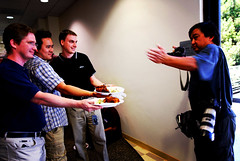 In honor of the first officially-sanctioned Lunch 2.0 at Yahoo today, I thought I would finally write something on how and why we started this valley phenomenon:
In honor of the first officially-sanctioned Lunch 2.0 at Yahoo today, I thought I would finally write something on how and why we started this valley phenomenon:
Living in Silicon Valley is expensive, and the traffic on 101 sucks. So why not telecommute from, say, somewhere in the Midwest? What does living out here get you that working remotely doesn’t? Well, for one, all the other cool companies are out here. And, more importantly, the smart, innovative people behind those companies all live and work out here. But except for hiring employees, we rarely take advantage of that fact. We read about these companies in the blogs, and we use their products, and we’d probably all love to see how these companies and people live and work, but we don’t. Even though they’re like 5 minutes away from us, and they’re full of people just like us that would love to see how we live and work too!
And though many silicon valley companies are ostensibly at least somewhat in competition with one another, I think in most aspects we’re all kindred spirits fighting the same fight””trying to transform the world through technology and build a successful, functioning organization in the process. We all face the same issues: prioritizing features, hiring, nurturing a happy and productive work environment, dealing with growth, dealing with meetings and process (how much is too much? How little is too little?) and so on. Yet we rarely talk about these things, mainly because we’re all so busy trying to figure them out on our own. While traditional conferences may fill this need to some degree, they’re usually too big, too expensive, too impersonal, and too infrequent to appeal to most working people in the valley. But lunch is a perfect venue to get together, “talk shop”, and see how each other are set up. Everyone has to eat, it’s an informal setting, and it tends to be a manageable size. And silicon valley is such a small, closely connected world, that we know people at all the companies we care about within a degree or two of separation.
So initially, we just started doing this ourselves, e.g. “hey, you know so-and-so at Yahoo, can we go meet him for lunch next week?” or “my friend has this new startup and they just got an office, let’s go see them”. We thought others would be interested to see what we had seen, so we took photos and posted them online (in the process, coining “lunch 2.0” since we needed a name for the site, and it felt like a web-2.0 approach to the problem of meeting people). We also blogged upcoming events, but mainly just as an alternative for managing a mailing list of our few friends that wanted to come to these events. As we told our friends what we were doing, more and more wanted to come too, so we just pointed them to the blog, not thinking much of it.
The “we” in this case was initially me, Mark Jen (yes, that Mark; he joined Plaxo right after leaving Google), and Terry Chay from Plaxo (now at Tagged), and Terry’s friend Dave at Yahoo. Mark and I started having more lunches out at friends’ companies and Terry said he and Dave had been trying to do the same, so we quickly joined forces. Terry now tells people he was the “VC of lunch 2.0” because he plunked down the 5-bucks or so for the lunch20.com domain name. 🙂
The first company to realize that officially hosting lunch 2.0 would be a good thing was SimplyHired in early March ’06. Previously, we all just went to lunch with friends at Yahoo!, Google, and so on, but no one from the company officially “hosted” it, and certainly no one paid for us to eat. But Kay Kuo at SimplyHired wanted to get the word out about her company, so they ordered a bunch of food, gave us a tour of their office, demoed their site, and even gave us some free t-shirts! The event was a huge success, both for SimplyHired and for the people that came. Soon after, other companies started offering to host their own lunch 2.0 events. Mainly this was because someone from that company had attended a previous lunch 2.0 event, gotten excited, and gone back to tell their company they should do the same. Early lunch 2.0 hosts were Meebo, Plaxo, AOL, JotSpot, and Zvents.
Another big milestone was in May 06, when some people from Microsoft’s Silicon Valley Center got permission to host a lunch 2.0 event at their campus. This was definitely the most prominent company to host lunch 2.0 so far, and they did an amazing job, including paying for our lunch at the MSFT cafeteria, providing a tour of their 6-bldg campus, and bringing a lot of their own engineers to the event. By this point, lunch 2.0 had picked up enough of its own momentum that our roles as stewards changed from mainly trying to find and convince new people to host events to just coordinating times and logistics for companies that came to us and wanted to host. That trend has continued thus far, and shows no signs of slowing yet.
Other important milestones in lunch 2.0 history:
- When JotSpot hosted lunch 2.0, something like 45 people showed up. Previously the biggest event had around 20 people, so this was the first time we thought “whoa, this thing is really getting out there”.
- Meebo hosted a lunch 2.0 early in the summer and invited all summer interns in the valley to come. They had about 6 employees at the time and were sub-leasing a small amount of office space from another startup. About 80 people showed up, completely filling the office and spilling out onto the street.
- Zazzle hosted an outdoor BBQ at their office and attracted a record crowd of about 150 people. They also set up tables with umbrellas, a professional BBQ setup and buffet line, custom-printed posters and banners, and even custom-printed lunch 2.0 t-shirts for all attendees.
- Jeremiah from Hitachi Data Systems organized a combination lunch 2.0 and “web expo” at their executive briefing center. There were about 300 attendees, and we picked 10 data-intensive startups to bring laptops and set up an informal web expo where they could demo their products and talk about how they dealt with large amounts of data.
Going forward, it’s great to see that some of these events have gotten so large, but we also want to make sure that smaller startups can host lunch 2.0 events without feeling like they have to handle a ton of people or spend a lot of money. There are still plenty of cool companies in the area that we’ve never been to yet, so we’re hoping to keep doing lunch 2.0 for the foreseeable future.
Returning to those initial observations about making the most of living in the valley, I think the best thing that’s come from lunch 2.0 is that we’ve met so many other great people in the area, seen how they work, and they’ve met us in return. I feel more connected to what we’re all doing here, and I feel that I’m taking better advantage of the time and space in which we’re all living.



 Now that the
Now that the 